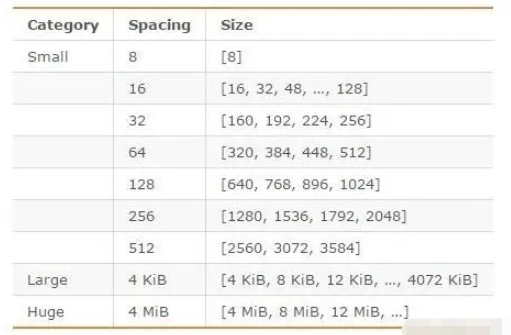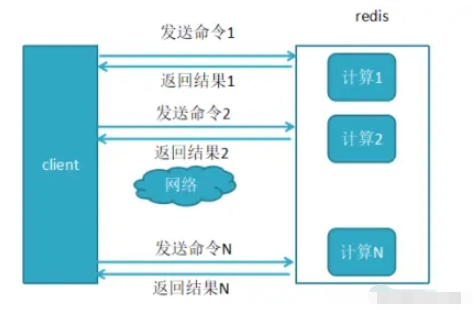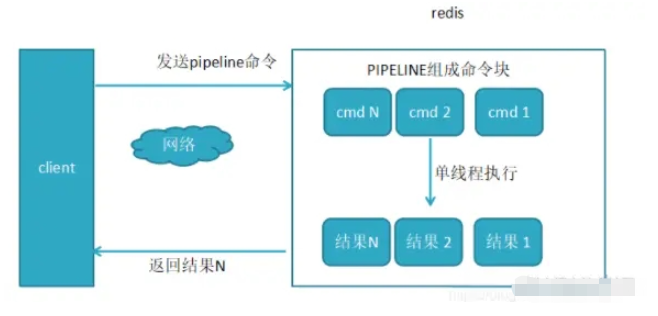What causes Redis memory fragmentation and what is the principle of Pipeline?
内存碎片
内存碎片如何产生的?
Redis内部有自己的内存分配器,默认是jemalloc,为了提高内存使用的效率,来对内存的申请和释放进行管理。内存分配器并不会完全按照程序请求的内存大小来分配,而是以固定大小来进行分配。 比如程序申请一个20字节的内存,内存分配器会分配一个32字节的内存空间,这么做是为了减少分配次数。redis会申请不同大小的内存空间来存储不同业务不同类型的数据,由于内存按照固定大小分配且会比实际申请的内存要大一些,这个过程中会产生内存碎片。 举个例子: 我们用高铁车厢说明,假设一个车厢的座位总共有60个,现在已经卖 了57张票,需要三张连在一起的票,但发现买不到了,只好换一趟车。我们可以把这些分散的空座位叫作车厢座位碎片。
内存碎片类似上面高铁座位的例子。虽然操作系统的剩余空间总量足够,但申请一块连续地址空间N字节时,剩余内存空间中没有大小为N字节的连续空间,那么这些剩余空间就是内存碎片。
Redis的这种机制,提高了内存的使用率,但是会使Redis中有部分自己没在用,却不释放的内存,导致了内存碎片的发生。
内存分配器
在编译时指定的Redis使用的内存分配器,可以是libc、jemalloc、tcmalloc,默认是jemalloc。
jemalloc在64位系统中,将内存空间划分为小、大、巨大三个范围;每个范围内又划分了许多小的内存块单位;存储数据的时候,会选择大小最合适的内存块进行存储。
jemalloc划分的内存单元如下图所示:

也就是说Redis是以指定大小的块为单位进行连续内存分配的,而不是按需分配的。Redis 会根据申请的内存最接近的固定值分配相应大小的空间。
这就好比你有多个箱子,需要用来装物品。你需要找到一个体积最接近的箱子来挑选。如果你发现在你把东西放进去后还有一些空间,你就不需要再去找箱子了。但是,这种分配空间的方式会带来一定程度的内存碎片。不同大小的划分空间可以被视为具有不同体积的盒子,每个盒子内的空间都有不同程度的剩余。这些剩余的空间就是内存碎片。
怎么看是否有内存碎片?
我们登陆到Redis服务器上,执行以下命令:
redis> info memory
我们会看到这些信息:

指标mem_fragmentation_ratio:1.86 表示当前的内存碎片率。
mem_fragmentation_ratio = used_memory_rss / used_memory
Redis申请的内存会被操作系统标记为used_memory_rss。 used_memory:是Redis中的数据占用的内存。
所以,mem_fragmentation_ratio=1应该是最理想的情况
碎片率的意义?
mem_fragmentation_ratio的不同值,说明不同的情况。
大于1:说明内存有碎片,一般在1到1.5之间是正常的。
大于1.5:说明内存碎片率比较大,需要考虑是否要进行内存碎片清理,要引起重视。
小于1:说明已经开始使用交换内存,也就是使用硬盘了,正常的内存不够用了,需要考虑是否要进行内存的扩容,使用swap是相当影响性能的。
清理内存碎片
低于4.0-RC3版本的Redis
如果你的Redis版本是4.0-RC3以下的,Redis服务器重启后,Redis会将没用的内存归还给操作系统,碎片率会降下来。
高于4.0-RC3版本的Redis
从Redis4.0-RC3版本开始,内存碎片整理可以在线上进行而无需重启。 自动碎片清理,只要设置了如下的配置,内存就会自动清理了。
redis> config set activedefrag yes
自动清理内存碎片的功能需要该Redis的内存分配器是jemalloc时才能启用。
启用后需要同时满足下面2个参数的设置条件时才会触发自动清理
active-defrag-ignore-bytes 100mb # 默认100MB,表示内存碎片空间达到100MB时 active-defrag-threshold-lower 10 # 默认10,表示内存碎片空间占OS分配给redis的物理内存空间的比例达到10%时
主线程在执行内存碎片自动清理时会耗费CPU资源,因为redis采用单进程模型。为了避免自动清理降低Redis的处理性能,如下两个参数可以控制清理动作消耗的CPU时间比例的上下限。
active-defrag-cycle-min 5 : 默认5,表示自动清理过程所用 CPU 时间的比例不低于5%,保证清理能正常开展; active-defrag-cycle-max 75: 默认75,表示自动清理过程所用 CPU 时间的比例不高于 75%,一旦超过,就停止清理,从而避免在清理时,大量的内存拷贝阻塞 Redis,导致响应延迟升高。
如果你对自动清理的效果不满意,可以使用如下命令,直接试下手动碎片清理:
redis > memory purge
需要注意的是,该清理命令也只当Redis的内存分配器是jemalloc时才能生效
#碎片整理总开关 activedefrag yes #当碎片达到 100mb 时,开启内存碎片整理 active-defrag-ignore-bytes 100mb #当碎片超过 10% 时,开启内存碎片整理 active-defrag-threshold-lower 10 #内存碎片超过 100%,则尽最大努力整理 active-defrag-threshold-upper 100 #内存自动整理占用资源最小百分比 active-defrag-cycle-min 5 #内存自动整理占用资源最大百分比 active-defrag-cycle-max 50
Pipeline管道
为什么需要Pipeline
Redis客户端执行一条命令分4个过程:
发送命令-〉命令排队-〉命令执行-〉返回结果
这个过程称为 Round Trip Time(简称RTT, 往返时间) ,mget mset有效节约了RTT,但大部分命令(如hgetall,并没有mhgetall)不支持批量操作,需要消耗N次RTT ,这个时候需要Pipeline来解决这个问题
在Pipeline模式中,命令被写入缓冲区,最后通过exec命令一次性发送给Redis执行,并返回执行结果。
1、未使用Pipeline执行N条命令

2、使用了Pipeline执行N条命令

原生批命令(mset, mget)与Pipeline对比
原生批命令是原子性,Pipeline是非原子性
原生批命令一命令多个key, 但Pipeline支持多命令,Pipeline 不支持事务,因为命令是一条一条执行的。
原生批命令是服务端实现,而Pipeline需要服务端与客户端共同完成
Pipeline的优缺点
pipeline 每批打包的命令不能过多,因为 Pipeline 方式打包命令再发送,那么 Redis 必须在处理完所有命令前先缓存起所有命令的处理结果。这样就有一个内存的消耗。
Pipeline 操作是非原子性的,如果要求原子性的,不推荐使用 Pipeline
使用Pipeline组装的命令个数不能太多,不然数据量过大,增加客户端的等待时间,还可能造成网络阻塞,可以将大量命令的拆分多个小的pipeline命令完成。
一些疑问
Pipeline 执行多少命令合适?
根据官方的解释,推荐是以 10k 每批 (注意:这个是一个参考值,请根据自身实际业务情况调整)。
Pipeline 批量执行的时候,是否对Redis进行了锁定,导致其他应用无法再进行读写?
Redis 采用多路I/O复用模型,非阻塞IO,所以Pipeline批量写入的时候,一定范围内不影响其他的读操作。
在编码时请注意,Pipeline 期间将“独占”链接,此期间将不能进行非“管道”类型的其他操作,直到 Pipeline 关闭;如果你的 Pipeline 的指令集很庞大,为了不干扰链接中的其他操作,你可以为 Pipeline 操作新建 Client 链接,让 Pipeline 和其他正常操作分离在2个 client 中。
相关代码
@Test
void pipeline() {
List<Object> result = redisTemplate.executePipelined((RedisCallback<String>) connection -> {
for (int i = 0; i < 100; i++) {
redisTemplate.opsForValue().set("pipel:" + i, i);
}
return null;
});
}
The above is the detailed content of What causes Redis memory fragmentation and what is the principle of Pipeline?. For more information, please follow other related articles on the PHP Chinese website!

Hot AI Tools

Undresser.AI Undress
AI-powered app for creating realistic nude photos

AI Clothes Remover
Online AI tool for removing clothes from photos.

Undress AI Tool
Undress images for free

Clothoff.io
AI clothes remover

Video Face Swap
Swap faces in any video effortlessly with our completely free AI face swap tool!

Hot Article

Hot Tools

Notepad++7.3.1
Easy-to-use and free code editor

SublimeText3 Chinese version
Chinese version, very easy to use

Zend Studio 13.0.1
Powerful PHP integrated development environment

Dreamweaver CS6
Visual web development tools

SublimeText3 Mac version
God-level code editing software (SublimeText3)

Hot Topics
 How to build the redis cluster mode
Apr 10, 2025 pm 10:15 PM
How to build the redis cluster mode
Apr 10, 2025 pm 10:15 PM
Redis cluster mode deploys Redis instances to multiple servers through sharding, improving scalability and availability. The construction steps are as follows: Create odd Redis instances with different ports; Create 3 sentinel instances, monitor Redis instances and failover; configure sentinel configuration files, add monitoring Redis instance information and failover settings; configure Redis instance configuration files, enable cluster mode and specify the cluster information file path; create nodes.conf file, containing information of each Redis instance; start the cluster, execute the create command to create a cluster and specify the number of replicas; log in to the cluster to execute the CLUSTER INFO command to verify the cluster status; make
 How to read redis queue
Apr 10, 2025 pm 10:12 PM
How to read redis queue
Apr 10, 2025 pm 10:12 PM
To read a queue from Redis, you need to get the queue name, read the elements using the LPOP command, and process the empty queue. The specific steps are as follows: Get the queue name: name it with the prefix of "queue:" such as "queue:my-queue". Use the LPOP command: Eject the element from the head of the queue and return its value, such as LPOP queue:my-queue. Processing empty queues: If the queue is empty, LPOP returns nil, and you can check whether the queue exists before reading the element.
 How to clear redis data
Apr 10, 2025 pm 10:06 PM
How to clear redis data
Apr 10, 2025 pm 10:06 PM
How to clear Redis data: Use the FLUSHALL command to clear all key values. Use the FLUSHDB command to clear the key value of the currently selected database. Use SELECT to switch databases, and then use FLUSHDB to clear multiple databases. Use the DEL command to delete a specific key. Use the redis-cli tool to clear the data.
 How to configure Lua script execution time in centos redis
Apr 14, 2025 pm 02:12 PM
How to configure Lua script execution time in centos redis
Apr 14, 2025 pm 02:12 PM
On CentOS systems, you can limit the execution time of Lua scripts by modifying Redis configuration files or using Redis commands to prevent malicious scripts from consuming too much resources. Method 1: Modify the Redis configuration file and locate the Redis configuration file: The Redis configuration file is usually located in /etc/redis/redis.conf. Edit configuration file: Open the configuration file using a text editor (such as vi or nano): sudovi/etc/redis/redis.conf Set the Lua script execution time limit: Add or modify the following lines in the configuration file to set the maximum execution time of the Lua script (unit: milliseconds)
 How to set the redis expiration policy
Apr 10, 2025 pm 10:03 PM
How to set the redis expiration policy
Apr 10, 2025 pm 10:03 PM
There are two types of Redis data expiration strategies: periodic deletion: periodic scan to delete the expired key, which can be set through expired-time-cap-remove-count and expired-time-cap-remove-delay parameters. Lazy Deletion: Check for deletion expired keys only when keys are read or written. They can be set through lazyfree-lazy-eviction, lazyfree-lazy-expire, lazyfree-lazy-user-del parameters.
 How to use the redis command line
Apr 10, 2025 pm 10:18 PM
How to use the redis command line
Apr 10, 2025 pm 10:18 PM
Use the Redis command line tool (redis-cli) to manage and operate Redis through the following steps: Connect to the server, specify the address and port. Send commands to the server using the command name and parameters. Use the HELP command to view help information for a specific command. Use the QUIT command to exit the command line tool.
 How to implement redis counter
Apr 10, 2025 pm 10:21 PM
How to implement redis counter
Apr 10, 2025 pm 10:21 PM
Redis counter is a mechanism that uses Redis key-value pair storage to implement counting operations, including the following steps: creating counter keys, increasing counts, decreasing counts, resetting counts, and obtaining counts. The advantages of Redis counters include fast speed, high concurrency, durability and simplicity and ease of use. It can be used in scenarios such as user access counting, real-time metric tracking, game scores and rankings, and order processing counting.
 How to optimize the performance of debian readdir
Apr 13, 2025 am 08:48 AM
How to optimize the performance of debian readdir
Apr 13, 2025 am 08:48 AM
In Debian systems, readdir system calls are used to read directory contents. If its performance is not good, try the following optimization strategy: Simplify the number of directory files: Split large directories into multiple small directories as much as possible, reducing the number of items processed per readdir call. Enable directory content caching: build a cache mechanism, update the cache regularly or when directory content changes, and reduce frequent calls to readdir. Memory caches (such as Memcached or Redis) or local caches (such as files or databases) can be considered. Adopt efficient data structure: If you implement directory traversal by yourself, select more efficient data structures (such as hash tables instead of linear search) to store and access directory information






